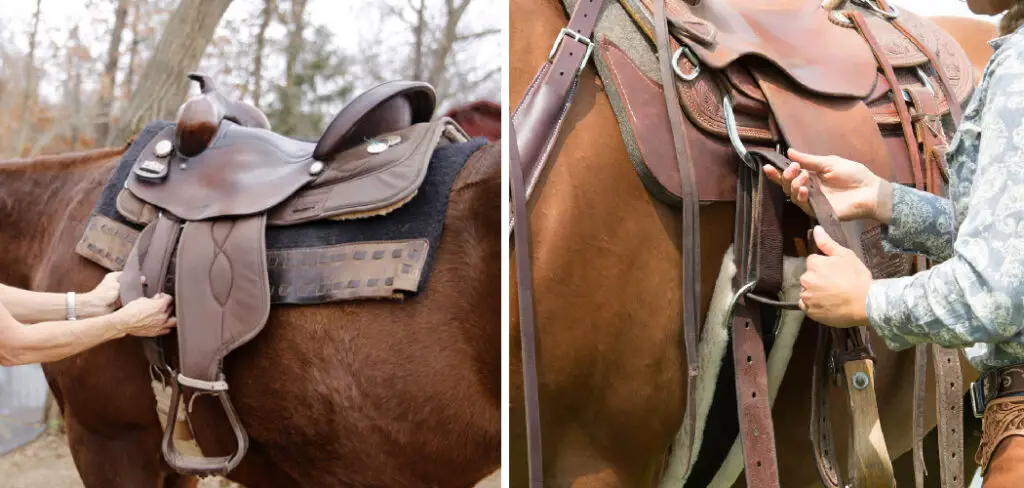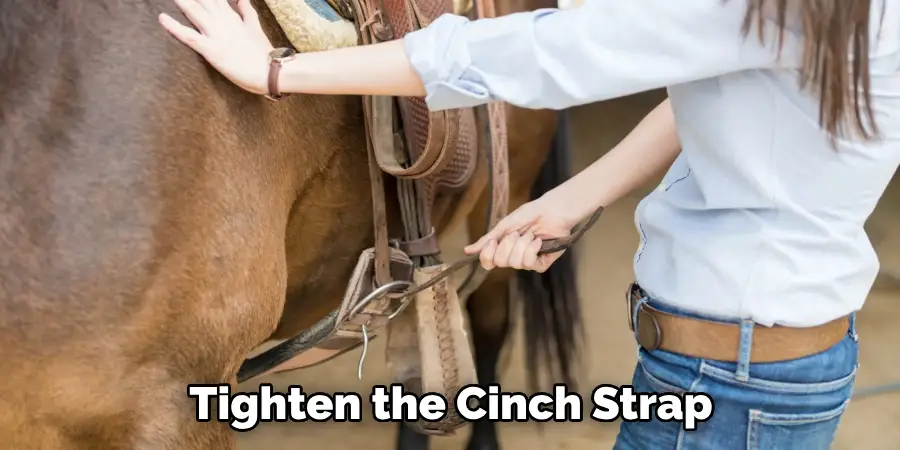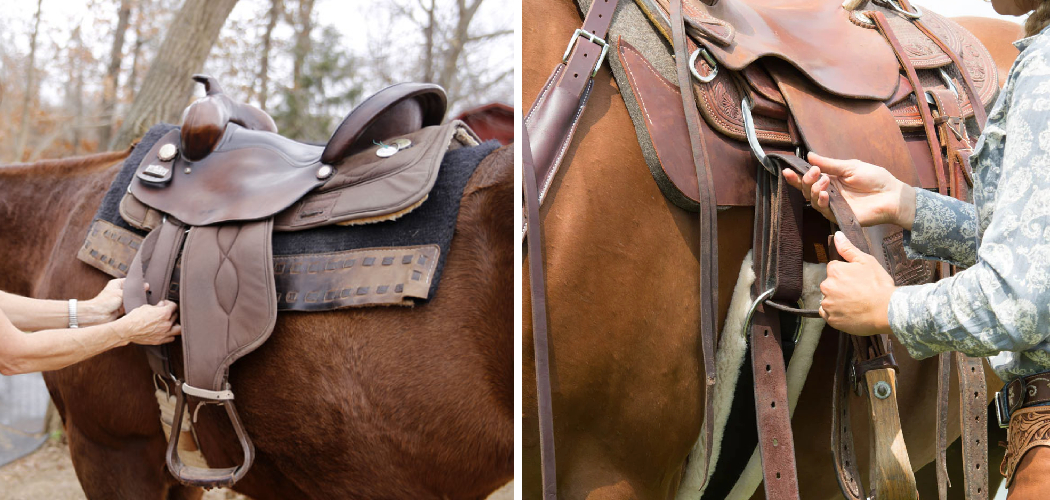Tying a latigo to the saddle is an essential skill for any horse owner or rider. A latigo is a long, narrow strip of leather that you use to secure the saddle to your horse’s back. It is fundamental to ensure that the saddle stays put and does not harm the horse. In this blog post, we’ll take you through all the necessary steps how to tie a latigo to the saddle.

Can You Tie a Latigo to The Saddle?
If you’re a horseback rider, you know that tying your horse to the saddle is an essential aspect of the sport. Not only does it keep you from losing your saddle, but it can also help keep your horse secure and ensure that your ride is smooth and comfortable. But if you’re new to the sport, you might wonder whether you can tie a latigo to the saddle.
The simple answer is yes, you can! Using a latigo is a common practice among horse riders, and it’s the perfect way to secure your horse to the saddle for a safe and enjoyable ride. So if you’re looking to explore the world of horseback riding, don’t hesitate to learn about using a latigo-it may just be the key to unlocking your true potential as a rider!
Why Should You Tie a Latigo to The Saddle?
Tying a latigo to the saddle may seem small and insignificant, but it can make all the difference when safely riding a horse. The latigo is a leather strap that is used to secure the saddle to the horse’s back. Without it, the saddle can easily slip or slide, causing discomfort or even injury to the horse.
By tying the latigo securely, you can have peace of mind knowing that your saddle will stay in place during your ride. Plus, taking the time to properly tie a latigo can also show your horse that you care about their comfort and safety, building a stronger bond between you and your equine partner. So the next time you saddle up, don’t forget to tie that latigo!
How to Tie a Latigo to the Saddle: Step-by-Step Guide
Step 1: Position the Saddle
Start by positioning the saddle on the horse’s back correctly. The saddle should sit evenly and comfortably on the horse’s withers. Place the saddle pad on the horse’s back before placing the saddle, ensuring that the pad stays centered under the saddle.

Step 2: Fitting the Latigo through the Cinch Ring
Next, fit the latigo through the cinch ring (the looped metal ring on the girth of the saddle). The latigo should be on the left side of your horse’s saddle. Ensure that the latigo remains comfortable in length while fitting through the cinch ring.
Step 3: Make a Loop around the Cinch Ring
Take the end of the latigo and loop it over the cinch ring. Ensure that if your saddle has a cinch buckle, the latigo passes through the buckle, so the cinch can be tightened around the horse. Make sure that the loop over the circumference is properly positioned.
Step 4: Bring the Latigo under the Cinch
Bring the latigo under the cinch and then bring it up and over to bring it back into the cinch ring. Make sure that the latigo is centered between the two billets. Pull the latigo up and keep it taught to ensure the cinch is secure.
Step 5: Tighten the Cinch
Lastly, tighten the cinch strap to keep the saddle secure. Ensure that you don’t overtighten the cinch, as this can cause pain to the horse. Tighten the cinch in a moderate manner so it fits comfortably and provides a secure hold.
Step 6: Check the Saddle Position
Once the cinch has been tightened, ensure the saddle still sits correctly and comfortably on your horse. If necessary, adjust the position of the saddle pad or make further adjustments to the cinch until it is secure and comfortable for your horse.

Step 7: Verifying Your Work
Once you have completed tying the latigo, check your work to ensure everything is secure and comfortable. You should also note any signs that your horse may be uncomfortable or show signs of pain. Make further adjustments until the saddle fits comfortably on your horse if necessary.
Regarding riding, having a secure and comfortable saddle is one of the most important aspects to consider. By following these steps, you can ensure that your saddle is properly secured and comfortable for your horse so that you can enjoy a safe ride.
5 Considerations Things When You Need to Tie a Latigo to The Saddle
1. Choosing the Right Latigo
When tying a latigo to a saddle, it is important to choose the right latigo for the job. The latigo should be made of durable, durable leather that won’t tear or stretch easily. It should also be long enough to reach the saddle and cinch it tightly. Additionally, the latigo should have a buckle or loop to be securely fastened to the saddle.
2. Adjusting The Length of The Latigo
Once you have chosen the right latigo, you must adjust its length to fit properly around your saddle. To do this, measure from one end of the saddle to the other and then subtract about two inches from this measurement. This will give you an approximate length for your latigo, which you can adjust accordingly.
3. Applying Lubricant
Before tying your latigo to your saddle, it is important to apply a lubricant such as neatsfoot oil or mink oil to both ends of the leather strap. This will help protect it from damage caused by friction when tightening and loosening the cinch knot. Applying lubricant will help keep your latigo supple and prevent it from becoming brittle over time.

4. Tying The Cinch Knot
Once you have adjusted the length of your latigo and applied lubricant, you are ready to tie the cinch knot to secure your saddle. To do this, wrap one end of the latigo around itself several times before threading it through a loop at its free end (or through a buckle). Then pull tight before securing with a half hitch knot at either end of the strap for extra security.
5. Checking For Security
Finally, once you have securely tied your cinch knot, check that everything is secure before riding away on your horse or mule! Make sure that all buckles are closed correctly and that there is no slack at either end of your latigo – if necessary, tighten up any loose straps until everything feels snug and secure against your saddle’s frame.
These five considerations will ensure that your latigo is securely fastened to the saddle and won’t come loose while riding out on the trail. Remember to inspect regularly for signs of wear and tear and replace as necessary for maximum safety. Happy trails!
Benefits of Tie a Latigo to The Saddle
Regarding horse riding, safety and stability are two of the most important factors. One way to enhance these essential elements is by tying a latigo to your saddle. A latigo is a long, flattened strip of leather that runs from the cinch to the saddle.
When properly tied, it helps to secure the cinch and prevents the saddle from slipping or shifting while riding. This added stability and security can significantly reduce the risk of accidents and improve your overall riding experience.
Additionally, tying a latigo to the saddle creates a smoother, more comfortable ride for you and your horse. With its many benefits, it’s clear that tying a latigo to your saddle is a smart and practical choice for any equestrian enthusiast!

Some Common Mistakes People Make When Trying to Tie a Latigo to The Saddle
The art of tying a latigo to the saddle has been passed down from generation to generation among horse enthusiasts. However, mistakes can happen, even to the most seasoned riders. One common mistake is tying the knot too tightly, which can result in discomfort and even injury to the horse.
Another mistake often made is not pulling the latigo tight enough, which can cause the saddle to shift during a ride. It’s important to remember that tying a latigo to a saddle is not just a process of securing the saddle to the horse but also ensuring the safety and comfort of the rider and the horse. With practice and patience, mastering the art of tying a latigo can make a world of difference in the overall riding experience.
Conclusion
Learning how to tie a latigo to the saddle is an essential skill that every horse owner should know. Every horse has a unique build and preference, so its comfort should always be the top priority.
Following the steps in this guide will help you do an effective and safe job when securing your horse’s saddle. Ensuring your horse has a comfortable saddle decreases the chances of any injuries or discomfort to your horse.

